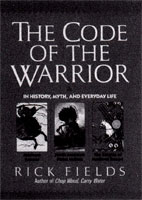The Code of the Warrior: In History, Myth, and Everyday Life
By Rick Fields.
HarperCollins: New York, 1991.
339 pp. $15.00 (paperback).
An ancient Chinese curse says “May you be born in an interesting time!” This epithet hangs over the inhabitants of the twentieth century, an era where not only war threatens our existence, but pollution, greed, overpopulation, and disease can seem overwhelming enemies. Yet when we examine the situation more closely, the enemy is—as always—ourselves. With the world poised on the edge of destruction, the timing is just right for this probing book by Rick Fields, author of How the Swans Came to the Lake, and Tricycle‘s Editor-at-Large.

Fields’ account of the warrior in history ranges from the origins of war in early agricultural societies to the development of the warrior in Asia, Europe, the Middle East, and North America, and the emergence of contemporary warriors—the “businessman warrior” and the defenders of the environment. Subjects addressed span the records of humanity from early cave paintings to present-day urban technology, and Fields connects each period of military development to the dominant spiritual, political, and economic forces of the era. Relationships and interconnections are untangled to reveal impressive, intricate patterns of cause and effect. Fields not only examines the development of a warrior in a specific cultural context but explores the influences of clashing warrior cultures and the emergence of the path of the warrior as a spiritual “way.”
Figures emerge at a dizzying pace only to rest for a paragraph or two in this comprehensive, encylopedic history. Fields astutely analyzes the influences that shaped each of these warriors: economic and religious in the case of the medieval crusader, aesthetic and political with regard to the bushido code of the Samurai, and the meditative discipline essential to the emergence of the Tibetan “Shambhala” warrior.
Contrasts drawn between battle strategies prove fascinating: the fierce Norse warriors called berserkirs are associated with the invocation of blind rage, while Aryan fighters aim for maximum emotional control—a discipline that contributed to the development of yoga. Fields deftly juxtaposes these histories to maximum effect and shows, for example, that while one leader relied on impressive, hierarchical battlefield display, the Chinese military philosopher Sun Tzu claimed that the best general wins without ever engaging in battle.
Discussions of courage, morality, and the need for self-examination recur throughout the text. Yet, while these meditations are impressive in their range, the author frequently sacrifices depth for scope. Too many of these chronicles approach their subjects from the outside only, leaving readers to guess at the motivation that led these warriors to take up their path. But two chapters—those devoted to Crazy Horse and Ueshiba, the founder of Aikido—delve deeply into their subjects and offer the reader an understanding of the warrior code from the inside. In his discussion of Aikido the author hits his stride—the descriptions are complex and illuminating. And Fields offers a stunning account of the circular principles of the universe as they are reflected in this martial art.
An historical and spiritual history of the warrior is a doubly difficult task: not only must the author create an accurate history, he also must address each warrior within his own cultural context. Fields does an admirable job when it comes to scholarship, but he falls short in the area of cultural relativism. He neglects the woman warrior by concentrating only on women who model their behavior on “yang” or “male” warrior codes, and only briefly touches on the nonviolent “warrior,” as exemplified by Gandhi. Virtually no attention is devoted to the “yin” warrior whose strength manifests itself in feats of endurance such as giving birth, waging a struggle for civil rights, or simply facing the fears of daily life. Despite these shortcomings, Fields has succeeded in providing a provocative overview of the past that makes this book essential reading for any student of history and the warrior way.